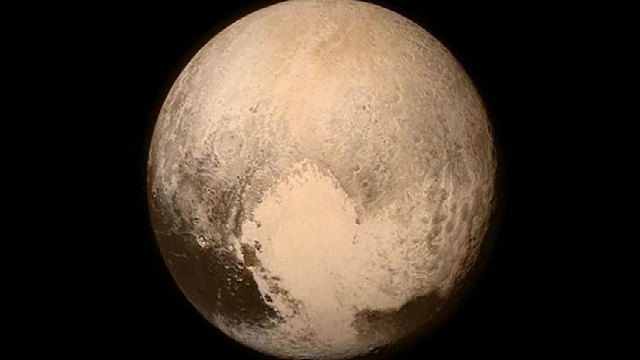
Pluto Up Close: Spacecraft Achieves Flyby, Then Calls Home
NASA has created an history getting up a close view of Pluto which is almost 3 billion miles away. According to the reports, NASA’s New Horizons spacecraft got humanity’s first up-close look at Pluto on Tuesday, sending word of its triumph across 3 billion miles to scientists waiting breathlessly back home.

Confirmation of mission success came 13 hours after the actual flyby and, after a day of both jubilation and tension, allowed the New Horizons team to finally celebrate in full force.”This is a tremendous moment in human history,” John Grunsfeld, NASA’s science mission chief, said at a news conference.
Also Read: 5-Year-Old Finds Hidden Camera in Starbucks Women’s Bathroom[VIDEO]
Principal scientist Alan Stern asked the entire New Horizons team in the audience to stand: “We did it! Take a bow! “The unprecedented encounter was the last stop on NASA’s grand tour of our solar-system’s planets over the past half-century. The journey began 9½ years ago, back when Pluto was still considered a full-fledged planet.
Tuesday morning, a cheering, flag-waving celebration swept over the mission operations center in Maryland at the time of closest approach. But until New Horizons phoned home Tuesday night, there was no guarantee the spacecraft had buzzed the small, icy, faraway — but no longer unknown — world.NASA said the spacecraft — the size of a baby grand piano — swept to within 7,700 miles of Pluto at 31,000 mph. It was programmed to then go past the dwarf planet and begin studying its far side.
Also Read: “Thank You Note to India From a Father in Pakistan”
To commemorate the moment of closest approach, scientists released the best picture yet of Pluto, taken on the eve of the flyby.Even better images will start “raining” down on Earth beginning Wednesday, promised principal scientist Alan Stern. But he had cautioned everyone to “stay tuned” until New Horizons contacted home.
It takes 4½ hours for signals to travel one-way between New Horizons and Earth. The message went out late in the afternoon during a brief break in the spacecraft’s data-gathering frenzy. The New Horizons team kept up a confirmation countdown, noting via Twitter when the signal should have passed the halfway point, then Jupiter’s orbit.The uncertainty added to the drama. “This is true exploration,” cautioned Stern, a Southwest Research Institute planetary scientist.
Also Read:Drunken Samajwadi Party Workers Allegedly Abducted a Bar Tender
Among the possible dangers: cosmic debris that could destroy the mission. But with the chances of a problem considered extremely low, scientists and hundreds of others assembled at Johns Hopkins University’s Applied Physics Laboratory erupted in jubilation when the moment of closest approach occurred at 7:49 a.m. EDT. The lab is the spacecraft’s developer and manager.The scene repeated itself a little before 9 p.m. EDT.
This time, the flight control room was packed compared with earlier, when it was empty because New Horizons was out of touch and operating on autopilot.”We have a healthy spacecraft,” announced mission operations director Alice Bowman. She was drowned out by cheers and applause; Stern ran over to give her a hug.Later, Grunsfeld told reporters, “The spacecraft is full of images. We can’t wait. We’ve opened up a new realm of the solar system.”Added NASA Administrator Charles Bolden: “What a phenomenal day.”